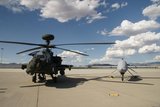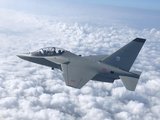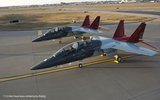I/ITSEC 2022: HII enhances human-machine teaming training for US Army
HII’s crewed-uncrewed teaming training system has been tested with the US Army’s Apache, but it can operate with any autonomous system with the right equipment to receive data.
Countries everywhere are feeling the effects of tightening belts caused by soaring inflation and even higher energy prices, while global security is more fragile than it has been for decades. (Photo: UK MoD/Crown Copyright)
Ahead of I/ITSEC 2022, the conference’s chair called for modelling, simulation and training experts to ‘enhance, adapt and accelerate’ solutions capable of meeting requirements through advanced technologies and new approaches.
The chair recognised that amidst declining financial powers and increased competition, it is more important now than ever that the industry and its military customers can implement new solutions and approaches before they become obsolete.
Although preparedness and training are increasingly critical, industry knows that militaries will be more prudent than ever when investing in shiny new technologies, as they will be expected to check their wallets before every decision. It is yet to be seen what novelties the T&S industry will bring to the world’s largest training and simulation show, but this is also true of the ways governments will balance the books in the coming years.
QinetiQ to demonstrate synthetic training for Royal Navy at I/ITSEC 2022
Simulation and training industry gathers for I/ITSEC 2022
I/ITSEC 2022: ASTi integrates simulated environment in Lockheed Martin demo centre
Countries around the world are feeling the effect of tightening belts caused by soaring inflation and even higher energy prices. At the same time, global security is more fragile than it has been for decades.
Governments, particularly NATO members, are confronted with the challenge of helping their citizens with the increased cost of living while also ensuring that their nations are prepared to fight and defend themselves and others.
At the beginning of October, the US Senate pushed back the passage of advanced defence budget plans for an $840 billion authorisation bill to November. This budget accounts for inflation costs, new equipment and further support for Ukraine, but planners clearly needed more time to work out the unknowns – how much further materiel will Ukraine need and thus how much money the US needs to set aside for restocking.
Similarly, the UK’s new Prime Minister Rishi Sunak and his chancellor have delayed the government’s fiscal statement by three weeks. Sunak’s short-lived predecessor, Liz Truss, had pledged to increase defence spending to 2.5% of GDP by 2026 and 3% by 2030. One could argue that these promises were easy to make as her premiership, even at the time, seemed unlikely to last until 2026, let alone until the end of the decade.
'Countries around the world are feeling the effect of tightening belts caused by soaring inflation and even higher energy prices.'
However, cutting back on defence in the current climate would be a complicated move for Sunak – or anyone else. Ministers within his own party voiced concerns that only a secure Britain can remain prosperous.
But sustaining shipments of equipment and support for Ukraine is also eating away significant resources, with the UK being the most generous European supporter of the invaded Eastern European country.
A little further from the eye of the storm, but still a fervent backer of Kyiv, Canada is expressing doubts as it grapples with stretched equipment and personnel capacity amidst foreign conflict and domestic natural disasters.
In these circumstances, the biggest challenge the T&S industry is facing is to maintain armed forces’ appetite to commit to new technologies and solutions. Even before things began to look so dire fiscally, there was a consensus that adopting new technologies without a proper training needs analysis can distract and disrupt training protocols.
The need for reduced carbon emissions and the desire to conduct large-scale, multi-nation exercises and training events in an affordable way may drive the adaptation of single synthetic environments (including digital twins and the ‘metaverse’). The jury, however, is still out on the virtual-live training equilibrium matter.
Additionally, the Canadian Armed Forces is still dragging its heels when it comes to incorporating simulations to a high degree across all domains. The UK also has a chequered track record of handling large-scale training programmes, with many of its current efforts involving virtual solutions facing delays.
The US may have the ability to throw large sums of money at its problems, but as the battered Integrated Visual Augmentation System (IVAS) programme reveals, more dollars are not necessarily the solution.
At a time of high military tension and stretched budgets, organisations may decide to circle back to proven concepts instead of spending money on futuristic technologies.
Shephard's I/ITSEC 2022 coverage is sponsored by:


HII’s crewed-uncrewed teaming training system has been tested with the US Army’s Apache, but it can operate with any autonomous system with the right equipment to receive data.

The Shephard Media news team looks at all the developments in the military training and simulation world, and discovers the trends and challenges in seabed warfare.

Leonardo is developing the Smart Chair system in its Battle Lab that allows for advanced pilot training for multi-domain scenarios and can potentially 'replicate a sixth-generation fighter jet cockpit'.

Boeing's T-7A Red Hawk simulator and maintenance training system will allow pilots and ground crew to train in novel ways as soon as the platforms are delivered.

Saab has increased training activities across core markets, opened combined training centres and is set to grow its business further.

CAE believes the future of training technologies will be fundamentally driven by bringing different industries together and no single company can exist in a vacuum - an approach that defence should adopt too.